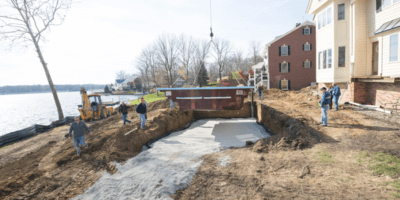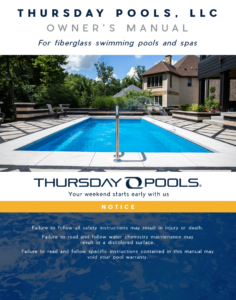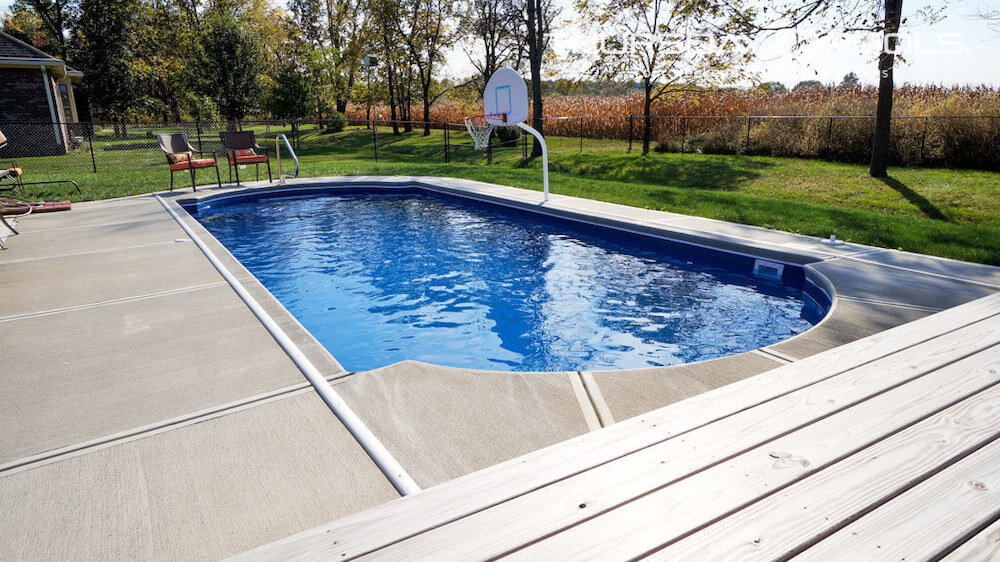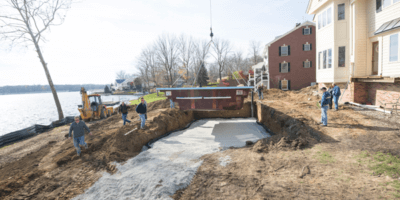Topic: Maintenance
How Do I Start Preparing to Close My Inground Fiberglass Pool?
When temperatures consistently fall below 65 degrees, it’s time to host the final pool parties of the season and start preparing to close your fiberglass pool. Preparing adequately for closing ensures a smooth transition into winter and a more effortless spring opening. To put your best foot forward, observe the following pool maintenance tasks to check off your list before winter.
Schedule Your Closing Date
Timing is crucial when it comes to pool closing. Contact your pool service company early to schedule a closing date. Taking a proactive approach to saving the date will help ensure you secure a spot before the busy closing season begins. Consider scheduling based on your climate and coordinate the date with other seasonal tasks to maximize efficiency. In colder climates, close the pool consistently before temperatures drop below freezing, typically between late September and mid-October. You may push closing to late October or early November in milder climates. If you live in an area with lots of falling leaves, you might want to close the pool earlier or use a cover to prevent debris buildup.
Properly balanced water will reduce the likelihood of algae growth and ensure cleaner water when you reopen the pool next year. Fiberglass pools are more algae-resistant than other types, thanks to their non-porous, smooth surface, which makes it harder for algae to attach and grow. However, if conditions are favorable, algae can still develop over winter, even in fiberglass pools. A stain and scale preventative product should also be added to protect the fiberglass surface during the off-season. When preparing for winterization:
- Adjust the pH to a level between 7.2 and 7.4.
- Adjust the alkalinity to 80 to 120 ppm.
- Adjust the calcium hardness to below 120 ppm.
- Add an algaecide according to product instructions.
- Add stain and scale remover per product instructions.
Pool supply stores offer winterization kits that often include everything you need, including algaecide and stain and scale preventatives. However, many pool owners enlist the help of a professional service to test their chemistry, adjust the water’s chemical levels, and complete other winter pool maintenance tasks.
Gather Your Equipment
Take the time to inspect all necessary winterization equipment, including winter plugs, skimmers, and maintenance tools. For easy access, items should be stored in one location, such as a garage or shed, to minimize time spent searching for tools. It’s also a great time to inspect all the equipment you’ll use upon opening your pool in the spring. If anything needs repair or replacing, handle it before closing so it won’t hinder your ability to enjoy your pool when the swim season comes around again.
Clean the Pool Thoroughly
Before closing your pool, it’s important to clean it thoroughly. Vacuum the pool to remove dirt and debris, scrub the water line, and backwash the filter (or remove and clean the cartridge filter if you have one). A clean pool is vital for closing as it will help you and the professionals enjoy a smoother closing process. It will also ensure the water is cleaner when you open next season.
Invest in a Quality Pool Cover
A reliable winter pool cover will help maintain the integrity of your pool during the off-season. Some pool cover options include:
- Solid Vinyl Covers with a Pump System: These covers are popular for winterizing because they are highly effective at blocking sunlight and preventing algae growth. They keep out debris and water. Look for covers with a built-in pump system to remove accumulated water on top.
- Mesh Safety Covers: Mesh safety covers are durable and allow rainwater and melted snow to drain through, which can be convenient. However, they let some sunlight through, so they’re not ideal in areas prone to algae. If you choose a mesh cover, opt for one with tightly woven mesh to limit light exposure as much as possible.
- Hybrid Covers: These combine the benefits of solid and mesh covers, providing more durability and sunlight blocking while allowing water to drain. They can be an excellent compromise for easy maintenance while reducing algae risk.
- Winter Covers with Air Pillows (for Freezing Climates): Air pillows placed under a solid or hybrid cover help prevent ice from damaging the pool walls by relieving pressure from expanding ice. This combination is especially beneficial if you live in a colder climate with freezing winters.
- Automatic Pool Covers: Automatic pool covers are durable, secure, and easy to use, providing a tight seal that keeps out sunlight and debris. They provide convenient year-round protection, are more expensive, and require a power source. However, they make checking your water levels and chemistry easier during the winter months and provide nearly instant safety in any season.
Store Pool Accessories Properly
Gather and clean all pool toys, floats, and accessories as you prepare to close. Deflate rafts and thoroughly wash them before storing them in a dry location, such as a garage or pool house. Additionally, according to manufacturer or pool professional advice, protect your diving board, slide, handrails, and ladders. For unremovable items, consider applying a protective wax for winter storage.
Safely Store Chemicals
Store any unused pool chemicals securely and safely to prevent accidents. It’s important to ensure that all chemical containers are tightly sealed to avoid leaks and spills. Store these containers in a well-ventilated area, away from heat sources such as furnaces or direct sunlight, as excessive heat can compromise the integrity of the chemicals. Additionally, store different types of chemicals separately. For instance, keep chlorine and shock treatments away from acids to prevent dangerous reactions. Consider organizing your chemicals by categorizing them, labeling each container clearly, and maintaining an inventory to track what you have. This organized approach enhances safety and makes it easier to find the chemicals.
Cherish the Days
As you prepare to tuck your pool away for winter, take a moment to look back on the memories you made this season. From lazy afternoons and lively pool parties to quiet swims at sunset, every splash holds a story worth sharing. Why not revisit the photos and videos you’ve captured, reliving those sun-soaked days. Let the anticipation of next season build, knowing that your winterizing preparations set the stage for more unforgettable poolside moments when warmer days return.
The Hidden Costs of Installing an Inground Pool
Installing an inground pool can transform your backyard into a personal oasis, offering a perfect relaxation, exercise, and entertainment spot. While upfront inground pool costs might seem manageable, there are numerous hidden costs that potential pool owners must consider. Understanding these hidden expenses for inground pools will help you make an informed decision and avoid unexpected financial burdens.
Initial Installation Costs

The initial installation is the most apparent cost. The process of installing an inground pool includes excavation, pool shell, plumbing, electrical work, and landscaping. The price varies significantly based on the pool type (concrete, vinyl, or fiberglass), size, and additional features like waterfalls or lighting. The installation can range from $25,000 to $120,000 on average, but this is just the beginning. Typically, vinyl inground pools are the cheapest way to build an inground pool when it comes to upfront installation costs. Fiberglass would follow next, and then concrete is typically the most expensive. It’s also important to note that these cost estimations are assuming the pool is installed by a professional pool builder. DIY inground pool costs may be less upfront, but if done incorrectly, it could cost you much more down the line to correct mistakes.
Excavation and Site Preparation: Before the pool installation, the builder must prepare the site. Site preparation involves excavation, which can be more complicated and expensive depending on your soil type, the presence of rocks, or any necessary grading. Unexpected obstacles during excavation can add a significant amount to the cost. Additionally, permits and inspections required by local authorities also add to the initial expenses.
Pool Shell and Materials: The choice of materials for your pool shell—concrete, vinyl, or fiberglass—impacts the overall cost. Each material has pros and cons, with concrete being the most durable, customizable, and expensive. Vinyl liners are the cheaper option in upfront expenses, but liners need replacement every 5-10 years on average. Fiberglass is a mid-range option in terms of cost and durability.
Maintenance Costs
Regardless of what material your pool is made of, regular maintenance is essential to keep it in good condition. Maintenance costs include chemical balancing, cleaning, equipment upkeep, and potential repairs. Required maintenance will also depend on your pool’s material. For example, concrete pools often require acid washing and replastering after a specific time, adding to your lifetime upkeep expenses.
Water Balance Treatments: Maintaining the correct chemical balance in your pool is essential for health and safety. The cost of chemicals such as chlorine, pH balancers, and algaecides can add up over time. Pool owners should expect to spend several hundred dollars annually on chemicals. Follow the recommended water chemistry levels per your pool’s manufacturer.
Cleaning and Repairs: Regular cleaning is necessary to keep your pool free of debris and algae. Whether you do it yourself or hire a pool service, maintaining an inground pool involves ongoing costs. Pool equipment such as pumps, filters, and vacuums also require maintenance and eventual replacement. Additionally, unexpected repairs due to equipment failure or structural issues can be costly.
Utility Costs: Pools consume a significant amount of water and electricity. Filling a pool the first time requires a large volume of water, and ongoing evaporation means you must top it off regularly. Refilling can be expensive, whether due to evaporation, leaks, or kids splashing. Water can be a significant cost, particularly in areas with high water prices or restrictions on water usage. The cost of running pool pumps, heaters, and lighting can significantly increase your utility bills, especially if you run them frequently. Pool heaters alone, particularly gas or electric models, consume a lot of energy. Efficient equipment and smart usage can help manage these costs, but they remain a substantial part of pool ownership. Electric use will likely cost you hundreds of dollars annually.
Winterization: In colder climates, pools require winterization to protect them from freezing temperatures. This process may involve draining the pool partially, adding antifreeze to the plumbing, and covering the pool securely. Please note: a fiberglass pool’s water level is NOT to be lowered for winterization, which could cause potential structural damage. Winterization and reopening in the spring come with labor and materials costs.
Insurance and Liability: Homeowners should consider the impact of an inground pool on their home insurance. Pools are often regarded as attractive nuisances and can increase liability risks. As a result, insurance premiums can rise significantly. Adding safety features such as fencing and pool alarms can mitigate some of these costs but are also an additional ongoing expense.
Other Considerations
Long-term Resale Value: While a pool can enhance your enjoyment of your home, its impact on resale value is mixed. In some markets, a pool can increase the appeal and value of a home, while in others, it can be a deterrent due to the associated maintenance costs and liability concerns. Potential homebuyers may also be wary of the hidden costs of owning a pool.
Legal and Regulatory Considerations: Local regulations may require specific safety measures such as fencing, alarms, or particular cover types. Ensuring compliance with these regulations may involve additional costs for installation and potential modifications. Be sure to discuss the local requirements for your pool with the pool builder who is installing it.
The Bottom Line of Inground Pool Costs
Inground pool installation comes with many costs you may not initially think about. Understanding these hidden costs allows you to make a more informed decision and enjoy your pool without unexpected expenses. When considering the lifetime ownership of a pool, a fiberglass pool is an excellent long-term investment. Try our fiberglass inground pool cost calculator for a ballpark estimate on a Thursday Pools fiberglass pool. If you are ready to get a detailed estimate, book a design consultation with an independent dealer in your area.


